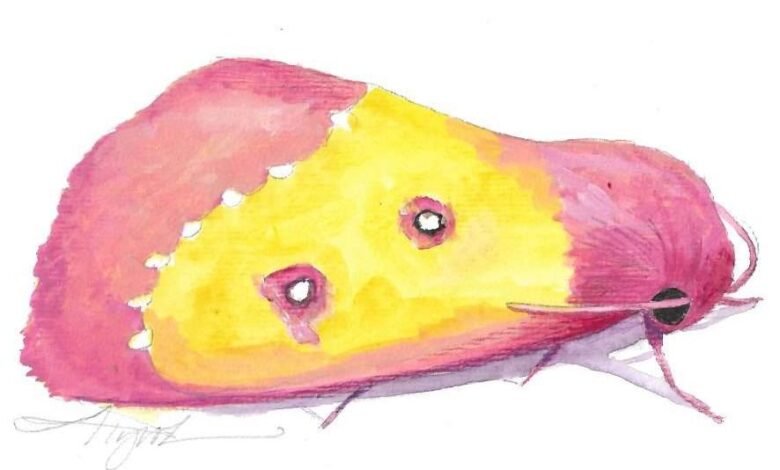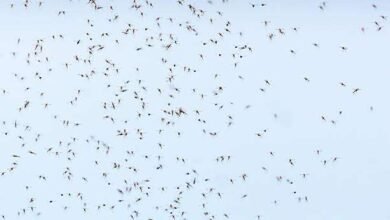Finding the Pink Star Caterpillar


 When I imagine scientists discovering new animals, I picture them traveling to far-off jungles or remote mountaintops – not investigating local roadsides, utility cuts, or other edge spaces of human habitation.
When I imagine scientists discovering new animals, I picture them traveling to far-off jungles or remote mountaintops – not investigating local roadsides, utility cuts, or other edge spaces of human habitation.
Yet late last summer, naturalists with The Caterpillar Lab in Swanzey, New Hampshire, found an unknown caterpillar on an unlikely host plant in an unassuming location.
During the summer of 2024, Logan Dieck, a high school senior and caterpillar enthusiast, was visiting from California to volunteer with The Caterpillar Lab. At the end of his trip, Sam Jaffe, the founder and director of the lab, took him out to look for caterpillars along the fringes of the local airport.
Jaffe hoped to find a few perennial favorites, perhaps a decorator emerald on daisy fleabane or a silver-spotted skipper on groundnut.
Jaffe described the area as sandy and full of tall, weedy plants. His eyes moved from one familiar caterpillar food plant to another, efficiently searching for the caterpillar favorites he wanted to show Dieck.
Dieck began an open-ended search, looking for anything that might be interesting. “I noticed a tiny brownish-red caterpillar on the ground,” he told me. It had brilliant white chevrons that stood out against the backdrop of plant life.
He picked it up and showed it to Jaffe, who later said, “I lost my mind. I know all the larger caterpillars you can expect to find here, and this didn’t fit in any of those boxes.”
Looking closer, they realized that the caterpillar had been sitting on a fallen, dead, and dry pinweed plant with distinctive feeding damage. The plant’s tiny round seeds had a neat, circular hole cut out of their tops and were completely hollowed out. Pinweed is rarely a food plant for any caterpillars, making Dieck’s find doubly fascinating.
Based on the caterpillar’s tough skin and striped coloration, Jaffe was confident it had to be one of the sun moths. He quickly worked up a short list of possible suspects, with the pink star moth (Derrima stellata) at the top. Although small – just an inch long – the pink star moth is an eye-catching combination of bright pink and yellow colors with metallic white eyespots.
It’s considered to be widespread but uncommon across the East Coast. The adult moth has been documented since 1858, but its caterpillar stage and host plants had remained a mystery.
Once naturalists and collaborators knew what to look for and where, they found an additional 40 to 50 caterpillars. To confirm Jaffe’s suspicion about the identity of these unknown caterpillars, they kept them after they pupated in the fall of 2024 and overwintered them at The Caterpillar Lab.
Sure enough, by late May of 2025, out came the first gorgeous adult pink star moths. There are many details about the lives of these moths that are still unclear, although Jaffe has some early ideas. He said the adult moths are likely out in June and July to mate and lay eggs on pinweed, with the caterpillars hatching in July and feeding into September.
They then leave their food plants to overwinter as pupae underground, emerging as adult moths again in June. He suspects they have a single generation each year. He also thinks it’s possible that these moths are more common than their reputation suggests but just aren’t very attracted to the light traps that naturalists typically use to catch moths.
This discovery provides a big piece of the puzzle toward understanding the pink star moth’s complete life history and ecological connections. Knowledge of their caterpillar appearance and host plant preference is already helping entomologists understand their distribution and relationships to similar species – it led to new evidence that spring-flying star moths in Florida are a distinct and currently unnamed species.
This discovery is a reminder that there is always something new to find, even in our own backyards. Jaffe said, “This is what we’re trying to do with the lab: go out and find cool things and bring them to people.” He’s currently working on a book to do just that: share these stories and fill in some of the mysteries of East Coast moths.
The work to understand the life of the pink star moth will continue. Before returning to California, Dieck assisted caterpillar expert David Wagner at the University of Connecticut with mapping the caterpillars’ setae (bristles).
Already, they’ve found microstructures on their skin that are unique. Dieck said, “Each caterpillar has a unique story to tell; each is worth learning about and appreciating.”
Read about caterpillars in New York State.
Rachel Sargent Mirus is a teaching artist and writer. Illustration by Adelaide Murphy Tyrol. The Outside Story is assigned and edited by Northern Woodlands magazine and sponsored by the Wellborn Ecology Fund of New Hampshire Charitable Foundation: nhcf.org.
Source link




